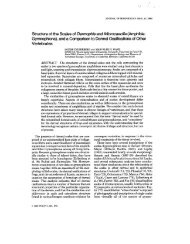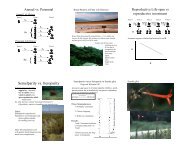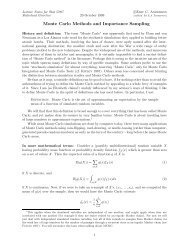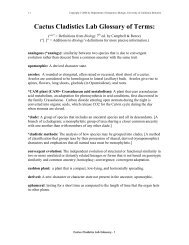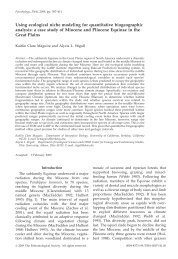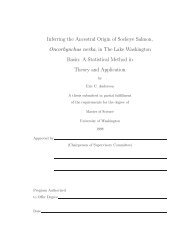Introduction to Cladistic Analysis - Integrative Biology - University of ...
Introduction to Cladistic Analysis - Integrative Biology - University of ...
Introduction to Cladistic Analysis - Integrative Biology - University of ...
You also want an ePaper? Increase the reach of your titles
YUMPU automatically turns print PDFs into web optimized ePapers that Google loves.
Copyright © 2009 by Department <strong>of</strong> <strong>Integrative</strong> <strong>Biology</strong>, <strong>University</strong> <strong>of</strong> California-Berkeley<br />
The five animals that possess the synapomorphies vertebrae and skull belong <strong>to</strong> this<br />
monophyletic group.<br />
Paraphyletic groups. A paraphyletic group consists <strong>of</strong> an ances<strong>to</strong>r and some <strong>of</strong> its<br />
descendants. A paraphyletic group is an incomplete clade, or a "grade". It is defined by<br />
the absence <strong>of</strong> at least one character (all group members lack some particular<br />
character[s]). Figure N gives an example <strong>of</strong> a paraphyletic group.<br />
Figure N. A paraphyletic group (enclosed by the thick line).<br />
sea urchin<br />
tunicate lamprey Cladoselache † trout lungfish frog<br />
no<strong>to</strong>chord<br />
skull<br />
vertebrae<br />
<strong>Introduction</strong> <strong>to</strong> <strong>Cladistic</strong> <strong>Analysis</strong> - 20<br />
jaws<br />
enamel<br />
swimbladder or lung<br />
This group lacks one descendant (frog) <strong>of</strong> the ances<strong>to</strong>r in which vertebrae and skull<br />
evolved. This paraphyletic group includes taxa that possess vertebrae and skulls but lack<br />
four true limbs.<br />
Polyphyletic groups. A polyphyletic group includes two or more taxa, but not the common<br />
ances<strong>to</strong>r <strong>of</strong> those taxa. A polyphyletic group is defined by at least one similar character<br />
that evolved independently (by convergent or parallel evolution) in each group member.<br />
Taxa are placed in a polyphyletic group because they share some superficial similarity, not<br />
because they're closely related <strong>to</strong> one another. Figure O gives an example <strong>of</strong> a<br />
polyphyletic group.<br />
four<br />
true<br />
limbs



